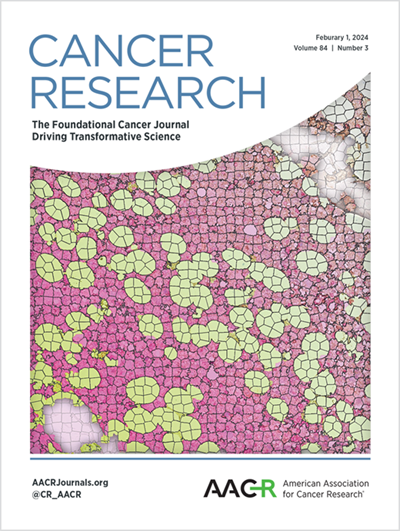Simultaneous Targeting of NQO1 and SOD1 Eradicates Breast Cancer Stem Cells via Mitochondrial Futile Redox Cycling.
IF 12.5
1区 医学
Q1 ONCOLOGY
引用次数: 0
Abstract
Triple negative breast cancer (TNBC) contains the highest proportion of cancer stem-like cells (CSCs), which display intrinsic resistance to currently available cancer therapies. This therapeutic resistance is partially mediated by an antioxidant defense coordinated by the transcription factor NRF2 and its downstream targets including NQO1. Here, we identified the antioxidant enzymes NQO1 and SOD1 as therapeutic vulnerabilities of ALDH+ epithelial-like CSCs and CD24-/loCD44+/hi mesenchymal-like CSCs in TNBC. Effective targeting of these CSC states was achieved by utilizing IB-DNQ, a potent and specific NQO1-bioactivatable futile redox cycling molecule, which generated large amounts of reactive oxygen species (ROS) including superoxide and hydrogen peroxide. Furthermore, the CSC killing effect was specifically enhanced by genetic or pharmacological inhibition of SOD1, a copper-containing superoxide dismutase highly expressed in TNBC. Mechanistically, a significant portion of NQO1 resided in the mitochondrial intermembrane space, catalyzing futile redox cycling from IB-DNQ to generate high levels of mitochondrial superoxide, and SOD1 inhibition markedly potentiated this effect resulting in mitochondrial oxidative injury, cytochrome c release, and activation of the caspase 3-mediated apoptotic pathway. Treatment with IB-DNQ alone or together with SOD1 inhibition effectively suppressed tumor growth, metastasis, and tumor-initiating potential in xenograft models of TNBC expressing different levels of NQO1. This futile oxidant-generating strategy, which targets CSCs across the epithelial-mesenchymal continuum, could be a promising therapeutic approach for treating TNBC patients.同时靶向 NQO1 和 SOD1 可通过线粒体氧化还原循环消灭乳腺癌干细胞
三阴性乳腺癌(TNBC)含有最高比例的癌症干样细胞(CSC),它们对目前可用的癌症疗法表现出内在的抗药性。这种抗药性部分是由转录因子 NRF2 及其下游靶标(包括 NQO1)协调的抗氧化防御所介导的。在这里,我们发现抗氧化酶NQO1和SOD1是TNBC中ALDH+上皮样CSCs和CD24-/loCD44+/hi间质样CSCs的治疗弱点。IB-DNQ是一种强效且特异的NQO1-生物活化无效氧化还原循环分子,能产生大量活性氧(ROS),包括超氧化物和过氧化氢,从而实现了对这些CSC状态的有效靶向治疗。此外,遗传或药物抑制SOD1(一种在TNBC中高度表达的含铜超氧化物歧化酶)可特异性增强对CSC的杀伤作用。从机理上讲,NQO1的很大一部分停留在线粒体膜间隙,催化IB-DNQ的徒劳氧化还原循环,产生高水平的线粒体超氧化物,而抑制SOD1会明显增强这种效应,导致线粒体氧化损伤、细胞色素c释放和激活caspase 3介导的细胞凋亡途径。在表达不同水平 NQO1 的 TNBC 异种移植模型中,单独使用 IB-DNQ 或同时使用 SOD1 抑制剂可有效抑制肿瘤生长、转移和肿瘤诱发潜能。这种针对上皮-间充质连续体中的癌细胞的无用氧化剂生成策略可能是治疗 TNBC 患者的一种很有前景的治疗方法。
本文章由计算机程序翻译,如有差异,请以英文原文为准。
求助全文
约1分钟内获得全文
求助全文
来源期刊

Cancer research
医学-肿瘤学
CiteScore
16.10
自引率
0.90%
发文量
7677
审稿时长
2.5 months
期刊介绍:
Cancer Research, published by the American Association for Cancer Research (AACR), is a journal that focuses on impactful original studies, reviews, and opinion pieces relevant to the broad cancer research community. Manuscripts that present conceptual or technological advances leading to insights into cancer biology are particularly sought after. The journal also places emphasis on convergence science, which involves bridging multiple distinct areas of cancer research.
With primary subsections including Cancer Biology, Cancer Immunology, Cancer Metabolism and Molecular Mechanisms, Translational Cancer Biology, Cancer Landscapes, and Convergence Science, Cancer Research has a comprehensive scope. It is published twice a month and has one volume per year, with a print ISSN of 0008-5472 and an online ISSN of 1538-7445.
Cancer Research is abstracted and/or indexed in various databases and platforms, including BIOSIS Previews (R) Database, MEDLINE, Current Contents/Life Sciences, Current Contents/Clinical Medicine, Science Citation Index, Scopus, and Web of Science.
文献相关原料
| 公司名称 | 产品信息 | 采购帮参考价格 |
|---|
 求助内容:
求助内容: 应助结果提醒方式:
应助结果提醒方式:


